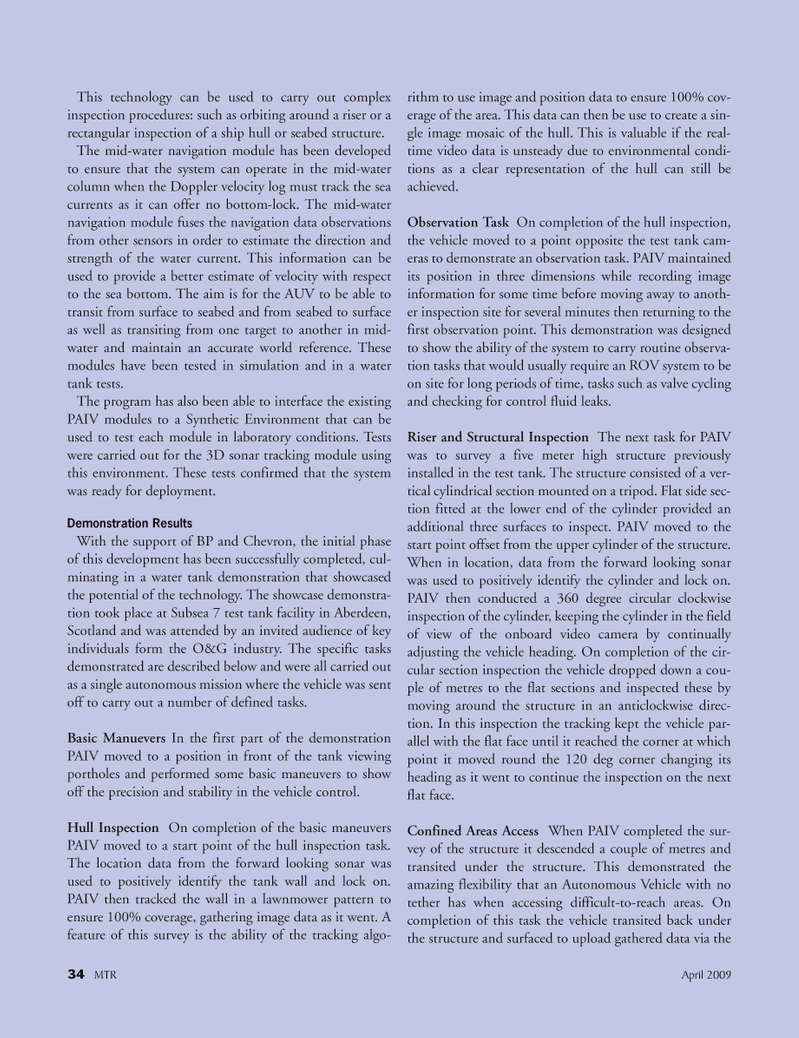
Page 34: of Marine Technology Magazine (April 2005)
Read this page in Pdf, Flash or Html5 edition of April 2005 Marine Technology Magazine
34 MTR April 2009
This technology can be used to carry out complex inspection procedures: such as orbiting around a riser or a rectangular inspection of a ship hull or seabed structure.
The mid-water navigation module has been developed to ensure that the system can operate in the mid-water column when the Doppler velocity log must track the sea currents as it can offer no bottom-lock. The mid-water navigation module fuses the navigation data observations from other sensors in order to estimate the direction and strength of the water current. This information can be used to provide a better estimate of velocity with respect to the sea bottom. The aim is for the AUV to be able to transit from surface to seabed and from seabed to surface as well as transiting from one target to another in mid- water and maintain an accurate world reference. These modules have been tested in simulation and in a water tank tests.
The program has also been able to interface the existing
PAIV modules to a Synthetic Environment that can be used to test each module in laboratory conditions. Tests were carried out for the 3D sonar tracking module using this environment. These tests confirmed that the system was ready for deployment.
Demonstration Results
With the support of BP and Chevron, the initial phase of this development has been successfully completed, cul- minating in a water tank demonstration that showcased the potential of the technology. The showcase demonstra- tion took place at Subsea 7 test tank facility in Aberdeen,
Scotland and was attended by an invited audience of key individuals form the O&G industry. The specific tasks demonstrated are described below and were all carried out as a single autonomous mission where the vehicle was sent off to carry out a number of defined tasks.
Basic Manuevers In the first part of the demonstration
PAIV moved to a position in front of the tank viewing portholes and performed some basic maneuvers to show off the precision and stability in the vehicle control.
Hull Inspection On completion of the basic maneuvers
PAIV moved to a start point of the hull inspection task.
The location data from the forward looking sonar was used to positively identify the tank wall and lock on.
PAIV then tracked the wall in a lawnmower pattern to ensure 100% coverage, gathering image data as it went. A feature of this survey is the ability of the tracking algo- rithm to use image and position data to ensure 100% cov- erage of the area. This data can then be use to create a sin- gle image mosaic of the hull. This is valuable if the real- time video data is unsteady due to environmental condi- tions as a clear representation of the hull can still be achieved.
Observation Task On completion of the hull inspection, the vehicle moved to a point opposite the test tank cam- eras to demonstrate an observation task. PAIV maintained its position in three dimensions while recording image information for some time before moving away to anoth- er inspection site for several minutes then returning to the first observation point. This demonstration was designed to show the ability of the system to carry routine observa- tion tasks that would usually require an ROV system to be on site for long periods of time, tasks such as valve cycling and checking for control fluid leaks.
Riser and Structural Inspection The next task for PAIV was to survey a five meter high structure previously installed in the test tank. The structure consisted of a ver- tical cylindrical section mounted on a tripod. Flat side sec- tion fitted at the lower end of the cylinder provided an additional three surfaces to inspect. PAIV moved to the start point offset from the upper cylinder of the structure.
When in location, data from the forward looking sonar was used to positively identify the cylinder and lock on.
PAIV then conducted a 360 degree circular clockwise inspection of the cylinder, keeping the cylinder in the field of view of the onboard video camera by continually adjusting the vehicle heading. On completion of the cir- cular section inspection the vehicle dropped down a cou- ple of metres to the flat sections and inspected these by moving around the structure in an anticlockwise direc- tion. In this inspection the tracking kept the vehicle par- allel with the flat face until it reached the corner at which point it moved round the 120 deg corner changing its heading as it went to continue the inspection on the next flat face.
Confined Areas Access When PAIV completed the sur- vey of the structure it descended a couple of metres and transited under the structure. This demonstrated the amazing flexibility that an Autonomous Vehicle with no tether has when accessing difficult-to-reach areas. On completion of this task the vehicle transited back under the structure and surfaced to upload gathered data via the
MTR#3 (34-49).qxd 3/27/2009 2:28 PM Page 34

 33
33

 35
35
